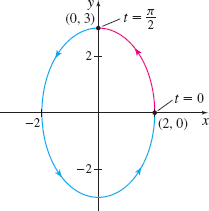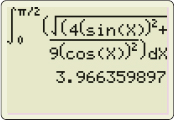EXAMPLE 6Using Technology to Find the Arc Length of an Ellipse

![]() Use technology to find the arc length s of the ellipse shown in Figure 17 traced out by the vector function r(t)=2costi+3sintj from t=0 to t=π2.
Use technology to find the arc length s of the ellipse shown in Figure 17 traced out by the vector function r(t)=2costi+3sintj from t=0 to t=π2.
Solution We begin by finding r′(t) and ‖ \mathbf{r}^{\prime} (t)=-2\sin t\mathbf{i}+3\cos t\mathbf{j}\qquad \left\Vert \mathbf{r}^{\prime} (t)\right\Vert =\sqrt{4\sin ^{2}t+9\cos ^{2}t}
Now we use the formula for arc length. \begin{equation*} s=\int_{a}^{b}\left\Vert \mathbf{r}^{\prime} (t)\right\Vert dt=\int_{0}^{\pi /2}\sqrt{4\sin ^{2}t+9\cos ^{2}t}\,dt \end{equation*}
This is an integral that has no antiderivative in terms of elementary functions. To obtain a numerical approximation to the arc length, we use a CAS or a graphing utility.
When entering the integral in WolframAlpha, we find \begin{equation*} \int_{0}^{\pi /2}\sqrt{4\sin ^{2}t+9\cos ^{2}t}\,dt\approx 3.96636 \end{equation*}
If we use a TI-84 to find the value of this integral, we obtain the same result. The screen shot is given in Figure 18.
